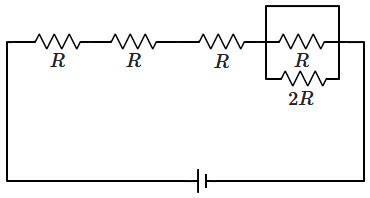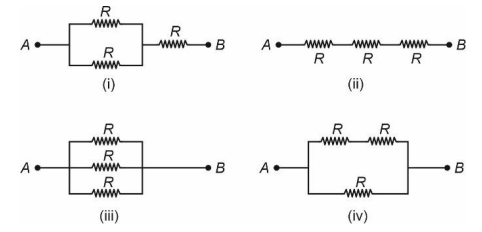Select Chapter Topics:
What is the equivalent resistance of the given circuit across the terminals of ideal battery?

1. \(2R\)
2. \(3R\)
3. \(4R\)
4. \(5R\)
Subtopic: Combination of Resistors |
72%
From NCERT
Please attempt this question first.
Hints
Please attempt this question first.
In the circuit shown, The current through \(R_{4}~(I_{4})\) and \(R_{5}~(I_{5})\) is:


| 1. | \(I_4=\dfrac{24}{55}~\text{A},~\text{and} ~I_5 = \dfrac{96}{55}~\text{A}\) |
| 2. | \(I_4=\dfrac{96}{55}~\text{A},~\text{and} ~I_5 = \dfrac{24}{55}~\text{A}\) |
| 3. | \(I_4=\dfrac{24}{37}~\text{A},~\text{and}~ I_5 = \dfrac{96}{37}~\text{A}\) |
| 4. | \(I_4=\dfrac{96}{37}~\text{A},~\text{and} ~I_5 = \dfrac{24}{37}~\text{A}\) |
Subtopic: Combination of Resistors |
78%
From NCERT
JEE
Please attempt this question first.
Hints
Please attempt this question first.
Select increasing order of power consumption.

1. \(P_1<P_2<P_4<P_3 \)
2. \(P_3<P_4<P_1<P_2 \)
3. \(P_4<P_3<P_1<P_2 \)
4\(P_2<P_1<P_4<P_3 \)

1. \(P_1<P_2<P_4<P_3 \)
2. \(P_3<P_4<P_1<P_2 \)
3. \(P_4<P_3<P_1<P_2 \)
4\(P_2<P_1<P_4<P_3 \)
Subtopic: Heating Effects of Current |
63%
From NCERT
JEE
Please attempt this question first.
Hints
Please attempt this question first.
If a wire of resistance \(R\) is connected across \(V_0\), then power is \(P_0\). The wire is cut into two equal parts and connected with \(V_0\) individually, then sum of power dissipated is \(P_1\) then \({P_0 \over P_1}\) is:
1. \(1\over 2\)
2. \(2\over 3\)
3. \(3\over 2\)
4. \(1\over 4\)
1. \(1\over 2\)
2. \(2\over 3\)
3. \(3\over 2\)
4. \(1\over 4\)
Subtopic: Heating Effects of Current |
71%
From NCERT
JEE
Please attempt this question first.
Hints
Please attempt this question first.
What is the ratio of potential difference across \(\)\(C_1\) and \(C_2\) at steady state for the given circuit?

1. \(4:5\)
2. \(2:5\)
3. \(1:4\)
4. \(3:1\)

1. \(4:5\)
2. \(2:5\)
3. \(1:4\)
4. \(3:1\)
65%
From NCERT
JEE
Please attempt this question first.
Hints
Please attempt this question first.
In the given circuit, the reading on the ideal voltmeter is equal to:

1. \(3~\text V\)
2. \(1.8~\text V\)
3. \(1.2~\text V\)
4. zero

1. \(3~\text V\)
2. \(1.8~\text V\)
3. \(1.2~\text V\)
4. zero
Subtopic: EMF & Terminal Voltage |
70%
From NCERT
JEE
Please attempt this question first.
Hints
Please attempt this question first.
Circuit I is converted to voltmeter after adding resistance R and current in circuit I is 1 mA. Circuit II is converted to ammeter after adding resistance r as shown. If current through battery in circuit II is 10 mA and current through galvanometer is 1 mA, then find R and r if resistance of galvanometer is 54 Ω.

1. R = 49946 Ω, r = 54 Ω
2. R = 6 Ω, r = 49946 Ω
3. R = 49946 Ω, r = 49946 Ω
4. R = 49946 Ω, r = 6 Ω

1. R = 49946 Ω, r = 54 Ω
2. R = 6 Ω, r = 49946 Ω
3. R = 49946 Ω, r = 49946 Ω
4. R = 49946 Ω, r = 6 Ω
Subtopic: Kirchoff's Voltage Law |
66%
From NCERT
JEE
Please attempt this question first.
Hints
Please attempt this question first.
In the given circuit, the current passes through \(20~\Omega\) is:

1. \(0.45~\text A\)
2. \(0.23~\text A\)
3. \(0.40~\text A\)
4. \(0.78~\text A\)

1. \(0.45~\text A\)
2. \(0.23~\text A\)
3. \(0.40~\text A\)
4. \(0.78~\text A\)
Subtopic: Kirchoff's Current Law |
67%
From NCERT
JEE
Please attempt this question first.
Hints
Please attempt this question first.
The effective resistance in the following circuit across terminal \(A\) and \(B\) is equal to:


| 1. | \(5~ \Omega\) | 2. | \(10 ~\Omega\) |
| 3. | \(20~ \Omega\) | 4. | \(40~ \Omega\) |
Subtopic: Combination of Resistors |
86%
From NCERT
JEE
Please attempt this question first.
Hints
Please attempt this question first.
Given below are two statements:
| Statement I: | In a series combination of resistors, the equivalent resistance is smaller than the individual resistances. |
| Statement II: | The resistivity of a wire depends on its temperature. |
| 1. | Statement I is True and Statement II is False. |
| 2. | Statement I is False and Statement II is True. |
| 3. | Both Statement I and Statement II are True. |
| 4. | Both Statement I and Statement II are False. |
Subtopic: Derivation of Ohm's Law |
71%
From NCERT
JEE
Please attempt this question first.
Hints
Please attempt this question first.






